Most of the vehicles that rush on the road are powered by four-stroke IC engines. Based on the working cycle these are further classified as petrol engines and diesel engines.
We notice four-stroke petrol engines in light or medium-duty vehicles like Motorcycles, Cars, ATVs, etc. In this detailed article, we will discuss four-stroke petrol engines.
Contents
What is Four stroke petrol engine?
The four stroke petrol engine is an IC engine that works on a petrol cycle and completes a single power cycle within four strokes of the piston or two revolutions of the crankshaft.
The term “four-stroke” indicates the engine in which a single working cycle is completed within four strokes of the piston (suction, compression, expansion, exhaust) while “Petrol” indicates the engine that works on a petrol cycle (Otto cycle).
As these engines use spark plugs for the combustion of the air-fuel mixture, these are also referred to as 4-stroke spark ignition (SI) engines. It runs on the fuels like gasoline, CNG, methanol, LNG, etc.
These engines are generally lighter and smaller in size than the four-stroke diesel engines as it uses a lower compression ratio (8 to 12) in comparison with 4 stroke diesel engines (14 to 24). Thus these engines are used to run low to medium-duty automobiles.
Four stroke petrol engine working cycle:
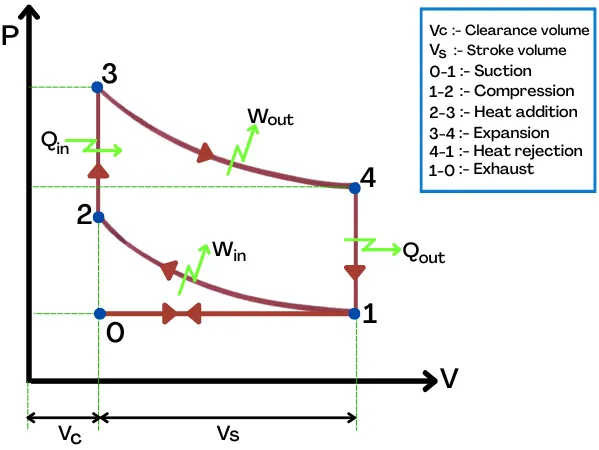
The four stroke petrol engine works on the principle of the Otto cycle. The cycle was invented by the German engineer Nicolaus Otto and mainly consists of two adiabatic and two isochoric processes.
It comprises the following processes:-
a) Process (0-1):- During this process, the piston sucks (pulls) the air-fuel mixture inside the cylinder at constant pressure P1.
b) Process (1-2):- It is an adiabatic compression process in which the piston compresses the air-fuel mixture inside the cylinder from pressure P1 to P2.
c) Process (2-3):- It is a constant volume heat addition process. In this process, a spark plug produces a spark, to ignite the fresh charge (Air + Fuel) which causes the pressure inside the combustion chamber to rise from P2 toP3.
d) Process (3-4):- It is an adiabatic expansion in which the high-pressure gases expand inside the cylinder from P3 to P4.
e) Process (4-1):- It is a constant volume heat rejection, during which the heat is rejected outside of the cylinder.
f) Process (1-0):- It is a constant pressure process in which burn gases are released from the cylinder into the exhaust Pipe.
Parts:
The Four Stroke Petrol Engine Consists of Cylinder, Piston, Connecting Rod, Crank, Inlet Port, Connecting Rod, Exhaust Port & Spark Plug.
These engines basically consist of the following parts:-
1) Intake Port and intake valve:- Inlet Port connects the cylinder to the intake manifold and its opening is controlled with the help of the intake valve. During the open period of the intake valve, a fresh charge from the intake manifold enters the engine cylinder.
2) Exhaust Port and exhaust valve:- Exhaust Port connects the cylinder to the exhaust manifold and its opening is controlled with the help of the exhaust valve. Burn gases from Cylinder are released into the exhaust pipe through the exhaust port.
3) Spark Plug:- Spark Plug is connected to the cylinder head. The spark plug produces a spark in the cylinder which helps to initiate the burning of fuel.

4) Cylinder:- The cylinder guides the movement of the piston and also helps to form the enclosed cavity for the combustion of the air-fuel mixture. It is connected between the cylinder head and the crankcase.
The size of the cylinders used in automobiles varies as per power requirements.
The capacity of the engine is specified by the volume inside the cylinder when the piston is at the bottom dead center.
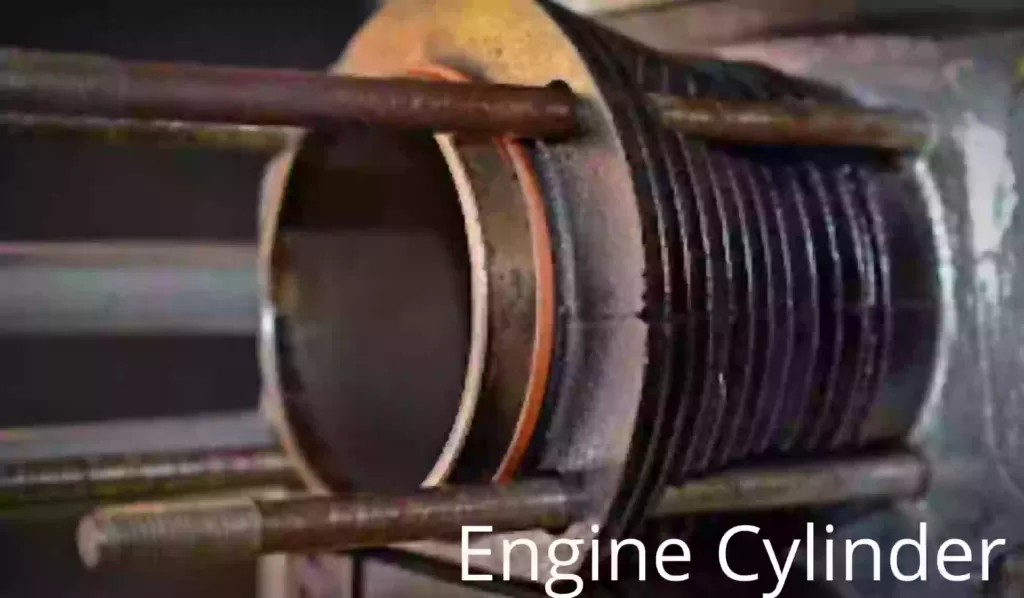
5) Cylinder head:- The cylinder head helps to form the upper enclosure of the combustion chamber. The inlet and exhaust ports are constructed on the cylinder head and it also has a provision for mounting the valves, spark plug, and valve actuating mechanism.
6) Piston: The piston reciprocates inside the cylinder to continuously change the volume enclosed in the cylinder which helps to perform the operations like suction, compression, expansion, and exhaust.
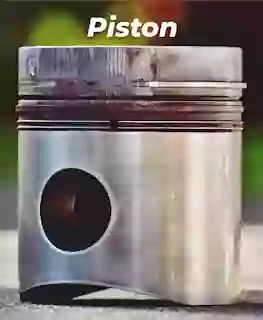
7) Connecting Rod: The connecting Rod connects the piston to the crank. One end of the connecting rod is connected to the piston while another end of the connecting rod is connected to the crank.
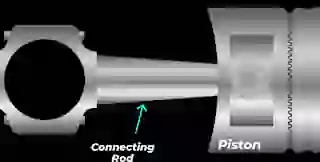
8) Crank and crankshaft:- The big end of the connecting rod is connected to the crank. The crank and crankshaft along with the connecting rod convert the reciprocating motion of the piston into the rotary motion.
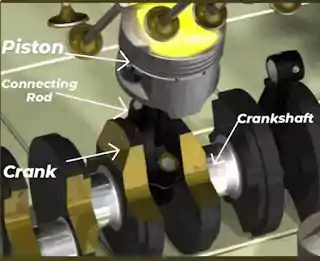
Construction of four stroke petrol engine:
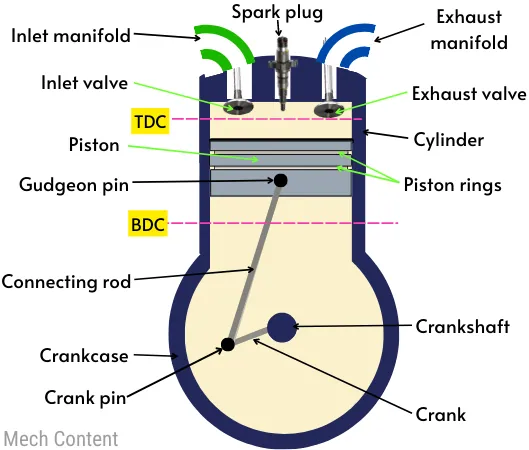
The 4 stroke petrol engine consists of stationary as well as moving components.
The stationary components of the petrol engine are the cylinder, cylinder head, crankcase, intake and exhaust manifold, spark plug, etc.
The moving components of the petrol engine are piston, connecting rod, crank and crankshaft, intake and exhaust valves, etc.
The cylinder head is mounted over the cylinder block and the piston is placed inside the cylinder to form a cylinder cavity or combustion chamber.
The piston easily reciprocates inside a cylinder and it is connected to the crankshaft with the help of connecting rod. This helps to convert the reciprocating motion of the piston into the rotary motion of the crankshaft and vice versa.
The inlet and exhaust valves are mounted into the cylinder head. The inlet valve actuates to control the entry of fresh charge from the intake manifold into the engine cylinder and the exhaust valve actuates to control the removal of exhaust gases from a cylinder to the exhaust manifold.
Terms used in 4 stroke petrol engine:
Following are some of the vital terms used in the case of the 4-stroke petrol engine, which will provide ease to understand the topic:-
TDC (Top Dead Centre):- It is the nearest position of the piston from the cylinder head. When the piston is at TDC, the volume inside the cylinder enclosed by the piston is minimum.
BDC (Bottom Dead Centre):- It is the farthest position of the piston from the cylinder head. When the piston is at BDC, the volume inside the cylinder enclosed by the piston is maximum.
Stroke:- The travel of the piston from the TDC to BDC or vice versa is known as stroke.
Stroke volume:- The volume of the cylinder from the position TDC to the BDC is known as a stroke/swept volume. It is also known as the volume swept by the piston from TDC to BDC.
Clearance volume:- When the piston is at TDC, the Volume enclosed by the cylinder and piston is known as clearance volume. It is the minimum volume inside the cylinder in the whole cycle.
A/F ratio (Air-fuel ratio):- It is the ratio of the mass of air to the mass of fuel present in the air-fuel mixture.
What are Four Strokes in Four Stroke Petrol Engine:
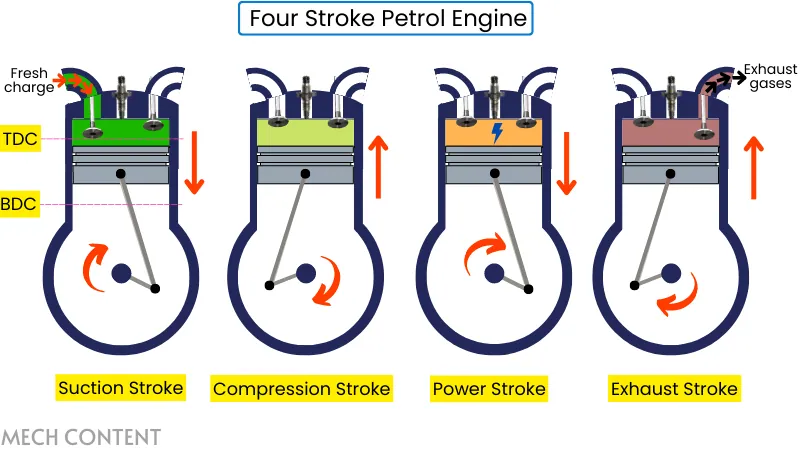
The working of the 4-stroke petrol engine comprises of the following 4 important strokes:-
1) Suction Stroke:- While suction stroke, the piston moves from TDC to BDC with the intake valve in open condition and the exhaust valve in closed condition.
During this stroke, as the piston moves from TDC to BDC, a partial vacuum is created inside a cylinder that helps to suck (pull) the air-fuel mixture from the intake manifold into the cylinder.
At the end of the suction stroke when the piston reaches the BDC, the inlet valve becomes closed.
2) Compression Stroke:– During the compression stroke, the piston compresses the air-fuel mixture to high pressure {inside the cylinder←Remove}. For this purpose, the piston moves from the BDC toward TDC. During a compression stroke, both valves (Inlet and Exhaust) remain in a closed condition. At the end of the compression stroke, the spark plug produces the spark to ignite the air-fuel mixture.
3) Power Stroke / Expansion Stroke:- In this stroke, the high-pressure combustion products push the piston downward (toward BDC) to get expand. Hence, the piston gets power due to the expansion of combustion products. During the power, stroke piston moves from the TDC toward BDC. At the end of the power stroke, the exhaust port becomes open.
4) Exhaust Stroke:- In Exhaust stroke, the piston moves from BDC to TDC. During this stroke, burn gases are released to Exhaust Pipe through an exhaust port. The exhaust valve becomes closed when the exhaust stroke is completed.
Working of four stroke petrol engine:
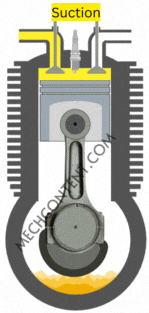
At the start of the combustion cycle, when the piston is at TDC, the intake valve becomes open and the exhaust valve remains in closed condition.
The first stroke is the suction stroke during which the piston moves from TDC to BDC. As the intake valve is in an open situation, the piston pulls the fresh charge from the intake manifold, thus the cylinder gets filled with the fresh charge. At the end of the suction stroke, when the piston reaches BDC, the intake valve becomes closed.
Now the piston moves from the BDC to TDC to compress the fresh charge trapped inside the cylinder. During this stroke, both the intake and exhaust valve remains in closed situation.
At the end of the compression stroke, the spark plug produces the spark to ignite the compressed air-fuel mixture. The combustion of the compressed charge results in the generation of high-pressure combustion products inside the combustion chamber.
These high-pressure combustion products push the piston from TDC to BDC. The movement of the piston due to the expansion of the combustion products is known as expansion stroke or power stroke. At the end of this power stroke (at BDC), the exhaust valve becomes open.
Now in the next stroke, the exhaust gases are expelled outside of the cylinder through the exhaust port due to the upward motion of the piston from BDC to TDC. At the end of this stroke, after reaching the piston to TDC, the exhaust valve get closed.
After Exhaust valve closes, the intake valve again becomes open and the fresh Air-fuel mixture again enters the cylinder Therefore cycle continues.
As the piston is connected to the crankshaft with the help of connecting rod, the reciprocating motion of the piston gets converted into the rotary motion of the crankshaft.
Valve timing diagram:
The valve timing diagram for four stroke petrol engine indicates the position of the piston or the position of the crankshaft during the opening and closing of the intake and exhaust valves, and generation of spark.
The valve timing diagram is different for the theoretical cycle and for the actual cycle. Lets discuss about each of them.
Theoretical valve timing diagram:-
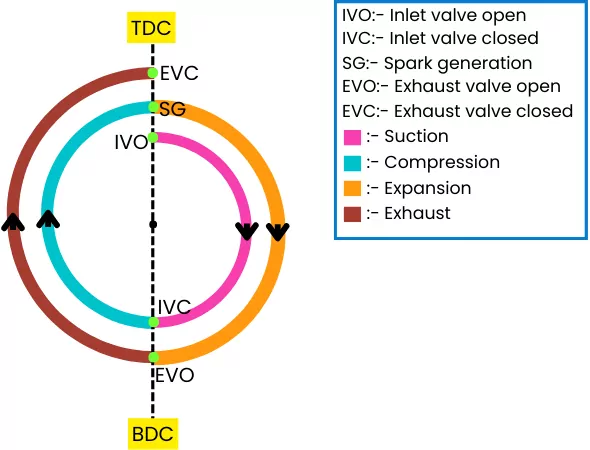
The above figure shows the valve timing diagram for a theoretical 4 stroke petrol engine. As shown in the above figure, at the start of the suction stroke, the intake valve opens exactly when the piston is at TDC and closes exactly when the piston reaches to BDC.
The spark generation in this theoretical cycle occurs when the piston is at TDC (starting of the expansion stroke). During the exhaust stroke, the exhaust valve opens when the piston is at TDC and it closes when the piston reaches to TDC.
Actual valve timing diagram:-
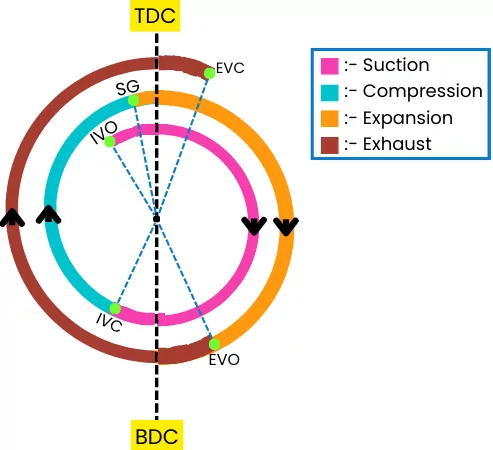
In the actual operation of the four stroke petrol engine, the inlet valve opens a few degrees before the piston reaches TDC, thus due to the valve overlap, the intake charge from the intake manifold helps to push the exhaust gases outside of the cylinder.
The inlet valve closes a few degrees after the BDC. During the suction stroke, when the piston reaches the BDC, the intake charge not completely enters into the cylinder and still the negative pressure is present in the cylinder.
Thus for completely feeding the intake charge into the cylinder, the closing of the intake valve is delayed by a few degrees after the TDC.
The spark generation occurs just a few degrees before the piston reaches to TDC. The combustion of intake charge and building of pressure is not an instantaneous process and takes a certain time. To avoid the delay in the building of pressure, the spark is generated a few degrees before the piston reaches TDC so that the building of pressure starts just after the piston reaches TDC.
The exhaust valve opens a few degrees before the piston reaches to BDC. It occurs to release the excessive pressure from the cylinder (at the end of the expansion stroke) and thus it helps to avoid pumping losses during the upward movement (exhaust stroke) of the piston.
The exhaust valve closes a few degrees after the TDC. Thus the intake and exhaust valve remains open for better scavenging of the cylinder.
Advantages of four stroke petrol engine:
The four stroke petrol engine has the following advantages:-
- The 4-stroke petrol engines work at high speed and low torque.
- The 4-stroke petrol engines work at a comparatively lower compression ratio.
- It does not require a high-pressure fuel injection system and fuel injectors.
- The engines are light in weight.
- The working of 4 stroke petrol engine is less noisy.
- Because of the spark plug, cold starting is easier in 4-stroke petrol engines.
- The initial cost of 4 stroke petrol engine is less.
- It has a lower maintenance cost.
- The engine creates fewer vibrations.
Disadvantages of four stroke petrol engine:
The four stroke petrol engine has the following disadvantages:-
- It requires an external device like a carburetor for the mixing of air and fuel.
- The fuel used by the four stroke petrol engine is highly volatile.
- The spark ignition system is required to ignite the compressed mixture.
- The cost of fuel used in four stroke petrol engine is comparatively high.
- It creates less torque than diesel engines.
- The 4 stroke petrol engine has lower thermal efficiency.
- It is not suitable for heavy load applications due to the less torque generation.
- This engine consumes more fuel for a unit amount of power generation, Thus it has lower specific fuel consumption.
Applications of four stroke petrol engine:
The four stroke petrol engine has applications in the following vehicles:-
- Auto-rickshaw
- Scooter
- Motorcycle
- ATVs
- Petrol Cars
- Generators
- Light-duty transport vehicles
Read also:
Very useful website. Thanks a lot. Thanks once again.
It’s a good site for purpose of learning
Best side to learning the petrol engine and stroke engine very nicely explain
Thanks 👍